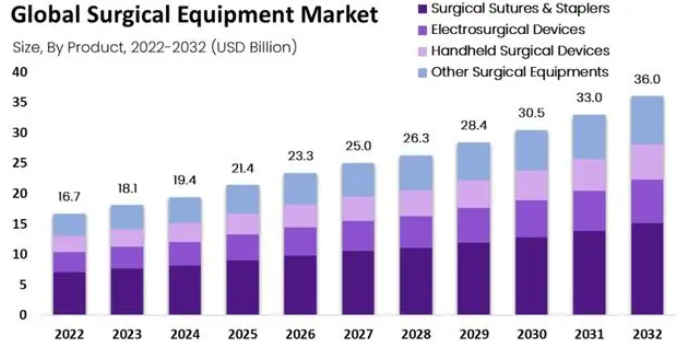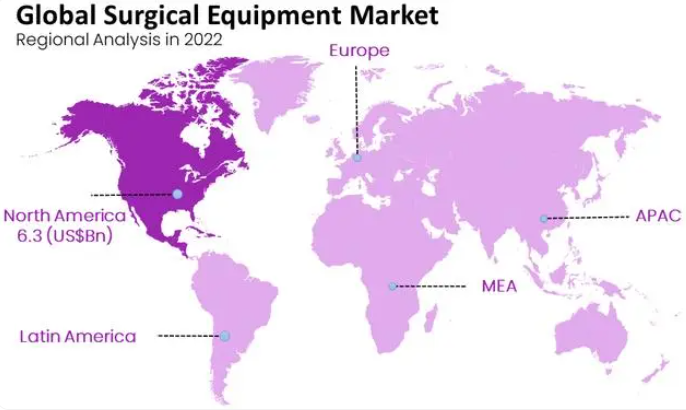The size of the global surgical equipment market is expected to reach approximately $36 billion by 2032, starting from $16.7 billion in 2022 and growing at a compound annual growth rate of 8.2% during the forecast period from 2023 to 2032.
Surgical equipment refers to instruments or tools used to perform functions such as cutting, grasping, separating, fixing, suturing, or pulling. Most surgical instruments are made of stainless steel. The market of surgical equipment is expanding rapidly, which is mainly due to the following factors: the increase in the incidence rate of lifestyle diseases ultimately leads to the increase in the demand for surgery, the increase in the proportion of the elderly population, the rise in medical care costs, and a large number of unmet surgical needs.
The advancement of minimally invasive surgical techniques, shortened postoperative hospitalization time, and the increase in the number of outpatient surgical centers are expected to drive the growth of the surgical equipment market during the forecast period.

The key points are summarized as follows:
Market growth: The surgical equipment market is expected to reach $36 billion by 2032, with a compound annual growth rate (CAGR) of 8.2% starting from $16.7 billion in 2022.
Product analysis: Surgical sutures and staplers dominate, with a market share of 42%.
Category analysis: Disposable surgical equipment is in a leading position and growing at a high compound annual growth rate.
Application analysis: Diversified surgical applications have driven the development of the market, among which the application of obstetrics and gynecology is showing an upward trend.
End user analysis: Hospitals hold the largest market share, thanks to advanced technology and the prevalence of diseases.
In 2022, North America dominated the market and held the highest revenue share, reaching 38%.
The Asia Pacific region is likely to grow at a significant compound annual growth rate between 2023 and 2032.
market factors
Driving factors
The increasing prevalence of chronic diseases and the growing aging population are driving market growth. The increase in the incidence rate of chronic diseases, the growth of the elderly population and the frequent occurrence of traffic accidents are the main factors driving the growth of the surgical equipment market. As age increases, the incidence of chronic diseases such as arthritis, cancer, and cardiovascular disease increases, leading to an increase in the number of people requiring surgical treatment.
With the continuous improvement of people’s understanding of minimally invasive surgery, the share of the global surgical equipment market is expected to grow at a faster rate. In addition, people are increasingly aware of the economic benefits brought by early surgical intervention, which is also a key reason for the increasing demand for surgery.
The increase in government investment helps to drive market growth. The government’s increased investment in encouraging foreign direct investment (FDI) and improving healthcare infrastructure in developing countries has driven the expansion of the surgical equipment market. In addition, the increasing incidence of accidents such as traffic accidents, sports injuries, and heart surgeries has also positively driven the demand for surgical equipment.
The development of surgical equipment and investment growth within the industry are also predicted to support the growth prospects in the coming years. In addition, healthcare providers are seeking to purchase surgical equipment with advanced technology.
limiting factor
Surgical equipment pollution hinders market growth. For the surgical equipment market, the main unfavorable factor is contamination of surgical instruments. The presence of a large number of bacteria on surgical instruments may lead to an increased incidence of infectious diseases. If disinfection is not thorough, surgical instruments are more susceptible to infection. This exposure may lead to surgical site infection.
In addition, another factor hindering the expansion of the surgical equipment market is the sale of counterfeit surgical instruments.
Growth opportunities
The growing aesthetic awareness and high demand for electric surgical tools. The popularization of minimally invasive surgery has greatly increased the demand for new electric surgical equipment and is expected to provide significant business opportunities for mature and emerging surgical equipment manufacturers during the forecast period. The increasing awareness of the benefits of portable electric surgical equipment among medical professionals and surgeons is expected to create new market opportunities in the coming years.
With the increasing influence of celebrities and social media influencers, the aesthetic awareness of the general public is also gradually improving. The number of people choosing plastic and cosmetic surgery (such as lip filling, breast reconstruction, hip implantation, etc.) is gradually increasing, which will also drive the demand for new surgical equipment.
Trend factors
The demand for surgical sutures and sutures has increased in various surgical procedures. The growing demand for surgical sutures and sutures worldwide has created numerous opportunities for original equipment manufacturers (OEMs) and medical technology companies in the surgical equipment industry. In order to sell their products, leading companies have adopted competitive pricing strategies combined with advanced technology.
The use of handheld tools is becoming a trend in medical institutions, especially hospitals. Therefore, the surgical equipment industry has achieved significant revenue growth from the research and development of new dilators and retractors. The global surgical equipment market is also expected to benefit from the development of higher quality products for surgical imaging.
Product Analysis
Surgical stapler and stapler occupy the largest market share. According to product classification, the surgical equipment market is divided into surgical stapler and stapler, electrosurgical equipment, handheld surgical equipment, and other surgical equipment. Among them, the surgical stapler and stapler segment will occupy the largest market share (42%) in 2023 and dominate the global market.
This is due to the high adoption rate of suturers and staplers widely used in wound closure surgery. The stapler part is expected to become the most profitable part, as it provides more advantages compared to the stapler, such as lower infection risk and faster wound healing speed.
Government initiatives and technological advancements are likely to drive the growth of the stapler market in the coming years. The electrosurgical equipment segment is expected to grow at the fastest compound annual growth rate (CAGR). This growth is attributed to the increased demand for electrosurgical equipment in minimally invasive surgery. The main participants in the market are committed to developing advanced electrosurgical equipment.
Category analysis
Disposable surgical equipment dominates the global market. By category, the market is further divided into disposable surgical equipment and reusable surgical equipment. In these two categories, disposable surgical equipment dominates and is expected to grow at the highest compound annual growth rate during the forecast period.
This can be attributed to their widespread use in various surgeries such as wound closure, plastic and reconstructive surgery, laparoscopic surgery, orthopedic surgery, and other procedures. Therefore, disposable surgical equipment has undergone significant development in the past few years.
Application analysis
Classified by application, the global surgical equipment market is divided into neurosurgery, orthopedics, obstetrics and gynecology, plastic and reconstructive surgery, cardiovascular, wound closure, and other applications. Among these applications, the other application segments hold the largest market share (28.0%) in 2023.
Due to the rising incidence rate of diseases related to female reproductive organs and the increasing number of deliveries worldwide, the department of gynecology and obstetrics holds the second largest market share and leads to an increase in the number of gynecological operations.
End user analysis
Hospitals hold the largest market share. According to the classification of end users, the market is divided into outpatient surgical centers, hospitals, and other end users. Among these end-users, hospitals held the largest market share in 2022 and are expected to maintain their dominant position in the coming years.
Normally, surgery is performed in a hospital. Due to the rise in the global incidence rate of diseases and the increase in the number of operations caused by trauma, chronic wounds, disability, chronic diseases and cancer, hospitals have become the main places for operations. In addition, the improvement of healthcare infrastructure, the availability of advanced technology and qualified surgeons, and the increase in surgical success rates are driving the growth of the surgical equipment market worldwide.
Regional analysis
According to regional classification, the global surgical equipment market is divided into North America, Europe, Asia Pacific, Latin America, and the Middle East and Africa. Among these regions, North America dominates the global market with a market share of 38.0%.
The region has a mature and well-established hospital system, high healthcare expenditures, and the presence of major market participants in the United States, which are the main factors driving the expansion of the surgical equipment market in the region. In addition, the increasing demand for minimally invasive surgery and technological advancements are expected to have a positive impact on market growth in the region.
It is expected that the Asia Pacific region will be the fastest-growing regional surgical equipment market during the forecast period. In regions such as China and India, with the increase of disposable income, the demand for plastic surgery and reconstructive surgery continues to rise, which is expected to promote market growth in the region. In addition, the increase in the elderly population in the Asia Pacific region is expected to lead to an increase in the number of cardiovascular and orthopedic surgeries.

market competition
Due to its wide product range and presence in the region, multiple players have a considerable market share. These major players are involved in various strategies, including new product development, distribution agreements, expansion, and market penetration strategies.
Due to the presence of numerous local and regional players, the market exhibits fragmented characteristics. Market participants face fierce competition from top market players, especially those with strong brand awareness and highly developed distribution networks. The company has adopted various expansion strategies, such as partnerships and product launches, to maintain its leading position in the market.
Currently, companies are utilizing their preferred methods for market research, such as mergers and acquisitions, expansion, investment, new product innovation, and establishing partnerships. In order to leverage business synergies and gain competitive advantages, these enterprises are also entering new markets and industries through mergers and acquisitions.




